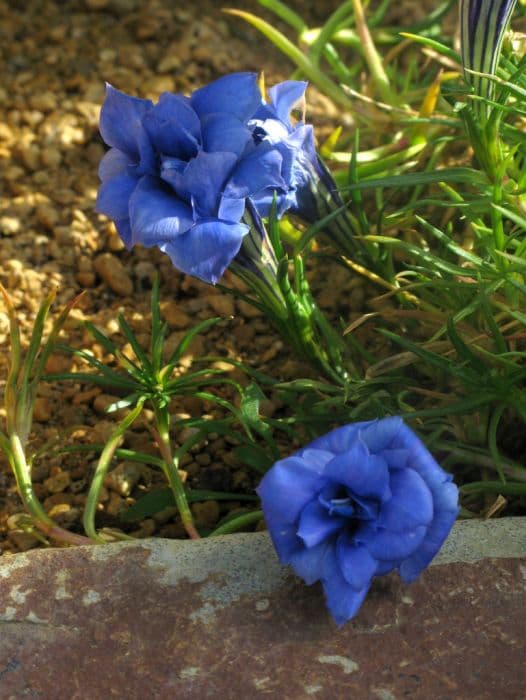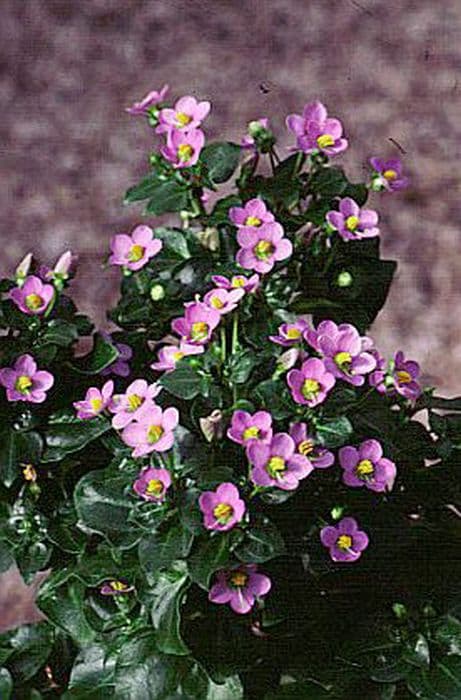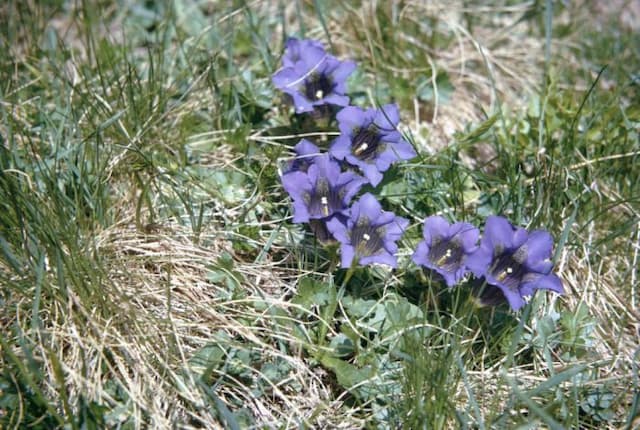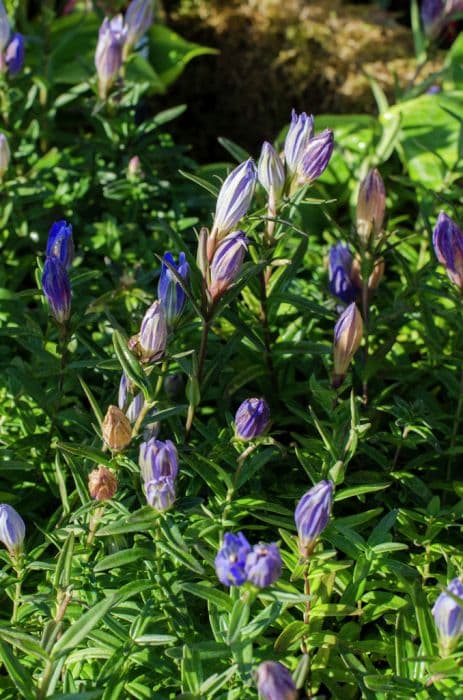Gentian Gentiana 'Lucerna'

ABOUT
Gentiana 'Lucerna', commonly known as 'Lucerna' gentian, is a striking plant renowned for its intense blue flowers. These trumpet-shaped blooms are a vibrant azure, often with greenish stripes or spots on the outside, adding to their visual appeal against the contrasting foliage. The leaves tend to be lance-shaped, emanating in a whorled pattern from the robust stems, boasting a crisp, deep green color that sets a lush backdrop for the blossoming flowers. The overall shape of 'Lucerna' is typically upright and clump-forming, presenting a tidy yet robust aesthetic in garden spaces. This plant tends to flower in the later parts of summer through to the fall, providing a late season burst of color. The flowers themselves are known for their delicate yet striking appearance and are one of the primary reasons 'Lucerna' is a favorite among garden enthusiasts for adding a pop of color to rock gardens, borders, or as part of a collection of alpine plants. Its overall appearance exhibits a balance of bright beauty and hardy resilience, making it a notable and cherished addition to various landscapes.
About this plant
 Names
NamesFamily
Gentianaceae
Synonyms
Lucerne Gentian
Common names
Gentiana 'Lucerna'.
 Toxicity
ToxicityTo humans
Gentian 'Lucerna', commonly known as Gentian, does not have a broad reputation for being toxic to humans. In fact, many species within the Gentian genus have a history of use in traditional medicine and are known for their bitter properties, which can aid digestion. However, like with any plant, individual allergic reactions or sensitivities could occur. In the absence of specific toxicity, there may be no symptoms of poisoning to describe for this plant.
To pets
Gentian 'Lucerna', commonly referred to as Gentian, is not widely recognized as being toxic to pets such as dogs and cats. Many gentians are not listed as poisonous to animals, and this particular cultivar is not commonly associated with toxic reactions in pets. Barring individual allergies or unique sensitivities, there may be no adverse symptoms experienced by pets ingesting parts of this plant.
 Characteristics
CharacteristicsLife cycle
Perennials
Foliage type
Deciduous
Color of leaves
Green
Flower color
Blue
Height
1-2 feet (30-60 cm)
Spread
1 foot (30 cm)
Plant type
Herb
Hardiness zones
5
Native area
Europe
Benefits
 General Benefits
General Benefits- Attracts Pollinators: Gentiana 'Lucerna' is known to attract butterflies and bees, which are key to pollination and the health of the ecosystem.
- Aesthetic Appeal: With its striking blue flowers, Gentiana 'Lucerna' adds beauty to gardens and landscapes.
- Easy to Grow: This plant is relatively low-maintenance, making it suitable for gardeners of all skill levels.
- Drought Tolerance: Once established, it is capable of withstanding periods of low water availability.
- Cold Resistant: Gentiana 'Lucerna' is hardy and can survive in cooler climates, making it a great choice for northern gardens.
- Soil Adaptability: It can grow in a wide range of soil types, although it prefers well-drained, acidic to neutral soil.
- Long Blooming Period: The plant has a long flowering season, often from late summer to fall, providing color when many other plants have ceased blooming.
 Medical Properties
Medical Properties- Not used for medical purposes.
 Air-purifying Qualities
Air-purifying QualitiesThis plant is not specifically known for air purifying qualities.
 Other Uses
Other Uses- Gentiana 'Lucerna', commonly known as Gentian, can be used as a natural fabric dye, providing fabrics with unique shades of blue and green dependent on the mordant used.
- In photography, Gentian extracts have been used in historical processes to produce cyanotype prints, which result in distinctive blue prints.
- Gentian flowers can serve as a biological indicator for alpine ecologists studying the impact of climate change on mountain habitats due to their sensitivity to temperature changes.
- Due to its striking blue flowers, Gentian is often used in floral arrangements and as a natural decorative element in crafts.
- The roots of Gentian can be infused in water to create a natural insect repellent for gardens and greenhouses.
- Gentian petals are sometimes incorporated into paper-making processes, adding flecks of color and texture to handmade papers.
- The plant is used in traditional art to create botanical illustrations, which are valued for both their aesthetic and scientific accuracy.
- Gentian's vibrant flowers are edible and can be used to add color and a slight bitterness to salads and as garnishes on desserts and cocktails.
- The symbolism of Gentian, which represents endurance and strength, is often utilized in literature and poetry as a metaphor.
- Gentian can be planted as a companion plant in gardens, attracting pollinators like bees and butterflies to the area.
Interesting Facts
 Feng Shui
Feng ShuiThe Gentian is not used in Feng Shui practice.
 Zodiac Sign Compitability
Zodiac Sign CompitabilityThe Gentian is not used in astrology practice.
 Plant Symbolism
Plant Symbolism- Perseverance: Gentians are known for their ability to thrive in harsh mountainous environments, symbolizing the trait of perseverance and the will to overcome challenges.
- Victory: Due to its association with overcoming obstacles, the Gentian flower also represents a symbol of victory and achievement.
- Faith: In some cultures, the Gentian is seen as a symbol of faith and trust, either in a spiritual context or in a personal sense.
- Strength: The robust nature of the Gentian, with its sturdy stem and vibrant color, often stands for inner strength and resilience.
- Love: Some interpret the Gentian as a symbol of love, especially an unrequited or enduring love that persists regardless of hardships.
 Water
WaterThe Trumpet Gentian requires consistent moisture, especially during the spring and summer when it's actively growing. Water the plant deeply once every week, ensuring that the soil becomes thoroughly moistened but not waterlogged. Depending on climate conditions, you might need to adjust watering frequency; if the weather is particularly hot or windy, additional water may be necessary. Conversely, during the fall and winter, when the plant is dormant, reduce watering to every few weeks, just enough to keep the soil from completely drying out. As a general guide, provide about 1-2 gallons of water per week during the growing season, decreasing to 1-2 gallons every few weeks in the dormant period.
 Light
LightTrumpet Gentian thrives best in full sun to partial shade conditions. It should be placed in a spot that receives at least four to six hours of sunlight each day, avoiding the intense midday sun which can scorch its leaves. The ideal location would be one that gets morning sunlight and is shaded during the hottest part of the afternoon.
 Temperature
TemperatureTrumpet Gentian prefers cooler temperatures and can tolerate a range from about 40°F to 75°F. It is hardy in temperatures as low as 20°F and should be protected from extreme heat, as temperatures consistently above 75°F can stress the plant. The ideal temperature for flourishing growth is between 50°F and 70°F.
 Pruning
PruningPruning the Trumpet Gentian is mainly for aesthetic purposes and to remove any dead or damaged foliage. Light pruning can be done in late fall or early spring to maintain the desired shape and to encourage new growth. The best time for significant pruning is in the spring before new growth begins so that cuts can heal quickly without affecting the plant's vigor. Prune as needed, typically once a year.
 Cleaning
CleaningAs needed
 Soil
SoilGentian 'Lucerna' thrives in well-draining, humus-rich soil with a slightly acidic to neutral pH around 5.0 to 7.0. A mixture of loamy soil, peat, and sand is ideal, ensuring good aeration and moisture retention without becoming waterlogged.
 Repotting
RepottingGentian 'Lucerna' typically requires repotting every 2 to 3 years to refresh the soil and accommodate growth. It's best to repot in the spring before new growth begins.
 Humidity & Misting
Humidity & MistingGentian 'Lucerna' prefers moderate humidity levels, consistent with its natural alpine habitat. A humidity level of around 50% is suitable for this plant.
 Suitable locations
Suitable locationsIndoor
Provide bright, indirect light and cool temperatures to grow Gentian 'Lucerna' indoors.
Outdoor
Plant in a rock garden or similar setting with good drainage.
Hardiness zone
3-7 USDA
 Life cycle
Life cycleGentiana 'Lucerna', commonly known as trumpet gentian, begins its life cycle as a seed that germinates in moist, well-drained soil in spring. Once the seedling emerges, it develops into a rosette of leaves at ground level, where it undergoes vegetative growth. As the plant matures, typically in the second year, it sends up flowering stems in late spring to summer, which bear striking, trumpet-shaped blue flowers that attract pollinators. After pollination, the flowers develop into seed capsules that disperse seeds, ensuring the continuation of the species. In the fall, the above-ground parts of the plant die back as it enters a period of dormancy, with the roots surviving through the winter. Each subsequent spring, the plant regrows from the rootstock, repeating its life cycle.
 Propogation
PropogationPropogation time
Spring-Early Summer
Propogation: The most popular method of propagating Gentian 'Lucerna' is by seed. The best time to sow seeds is in the late winter to early spring. To propagate by seed, one should first chill the seeds for a couple of weeks to simulate winter conditions, a process known as stratification. After stratification, seeds can be sown in well-draining seed starting mix, lightly covered with soil, and kept moist. It is essential to provide seeds with ample light and maintain a temperature around 60 to 70 degrees Fahrenheit (15.6 to 21.1 degrees Celsius). Seedlings will emerge in a few weeks, and once they are large enough to handle, they can be transplanted into individual pots and eventually moved outdoors once the risk of frost has passed.









